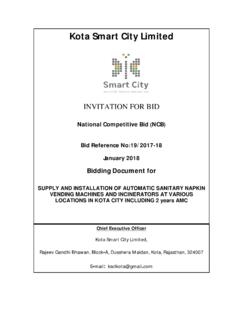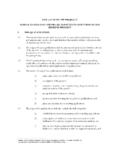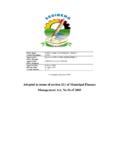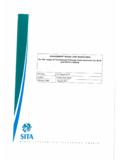Transcription of How the Federal Government Selects …
1 How the Federal Government Selects architect / engineering Firms The Brooks Act - the Basis for Awarding A/E Contracts The Brooks Act (Public Law 92-582, 40 541 et seq.), which was enacted on October 18, 1972, establishes the procurement process by which architects and engineers (A/Es) are selected for design contracts with Federal design and construction agencies. The Brooks Act establishes a qualifications-based selection process, know as "QBS," in which contracts for A/Es are negotiated on the basis of demonstrated competence and qualification for the type of professional services required at a fair and reasonable price.
2 Under Brooks Act procurement procedures, price quotations are not a consideration in the selection process. This QBS process, as established by the Brooks Act, has long been enthusiastically supported by every professional A/E society. This QBS process has long been enthusiastically supported by every professional A/E society for these reasons: Use of Qualifications-Based Selection can save money in life cycle costs. Comparison of price proposals works only when there are clear specifications on which competitors can base their bids. Bidding A/E services may reduce design standards and responsiveness to the needs of the owner.
3 Qualifications-Based Selection procurement is highly competitive. There are seven basic steps involved in pursing Federal design work under the Brooks Act: 1. Public solicitation for architectural and engineering services 2. Submission of an annual statement of qualifications and supplemental statements of ability to design specific projects for which public announcements were made 3. Evaluation of both the annual and project-specific statements 4. Development of a shortlist of at least three submitting firms in order to conduct interview with them 5. Interviews with the firms 6.
4 Ranking of at least three of the most qualified firms 7. Negotiation with the top ranked firm . A brief explanation of each of these steps, along with a description of what is involved in each, follows. The user must be reminded that while the above Brooks Act procedure is mandated by law, agencies may modify the procedures slightly, within the confines of the act and the Federal Acquisition Regulation. 1. Public Announcement The Brooks Act calls for public announcement of opportunities for design contracts. The Government fulfills this obligation by publicizing opportunities in the Commerce Business Daily.
5 The Commerce Business Daily, or "CBD," as it is known, is published Monday through Friday by the Department of Commerce. The CBD lists proposed Government procurements, subcontracting leads, and contract awards. A proposed procurement action appears in the CBD only once. All intended procurement actions of $25,000 or more, whether for military or civilian agencies, are published in the CBD. Also, this publication identifies contracts that have been awarded, if the contract amount exceeds $25,000 for civilian agencies and $100,000 for the Department of Defense.
6 The CBD does not list procurements that are: Classified for reasons of national security For perishable items For certain utility services Required within 15 days Placed under existing contracts For personal professional services Made only from foreign sources Not to be given advance publicity, as determined by the Small Business Administration These notices in the CBD give the location and scope of a project and may also contain such information as: Estimated construction contract award range Project schedule and the date and time limit for receiving replies Categories of evaluation criteria and weight factors Any requirements for submitting supplemental information.
7 Usually, opportunities for A/E services are listed under the "R" section. However, design opportunities can be included in other sections, such as those for design/build services (listed under "Y," Construction of Structures and Facilities). 2. Statements of Qualification A/E firms with an interest in being considered for design services contracts must submit the required statements of qualifications to each agency with which the A/E wants to contract. The Standard Form 254 (SF 254), architect -Engineer and Related Services Questionnaire, may be filed each year with a field office of each agency with which the architect intends to do business.
8 This form can also be updated and resubmitted at any time. A completed form furnishes the Federal agency with general information on the size, capabilities, personnel, and past experience of an interested firm . Many Federal agencies keep the SF 254 on file and review this file for prospective design firms if they have a small project that will not be advertised. The A/E firm can submit this form at the same time as the required project-specific form is submitted. The next statement of qualifications that a firm is to submit is the Standard Form 255 (SF 255), architect -Engineer and Related Services Questionnaire for Specific Project.
9 Following the review of the notices in the CBD, if an A/E firm wants to be considered for a specific project listed in it, then it must submit Standard Form 255, architect -Engineer and Related Services Questionnaire for Specific Project. This form is submitted in response to a specific solicitation and ,when completed, contains the data relative to the specific project. When a project is advertised in the CBD, the agency does not usually notify firms directly that have filed a SF 254. The project advertisements, or notices, that appear in the CBD are tailored to each specific project and invite interested firms to submit both the SF 254 and the SF 255, along with any supplemental data requested in the announcement.
10 Firms that have a current SF 254 on file with the listed procurement office are not required to resubmit that form; however, they must submit a SF 255, architect -Engineer and Related Services Questionnaire for Specific Project, to be considered for each separate project. Instructions on how to complete Standard Forms 254 and 255, which include substantial guidance on what information to add to your 254 and 255 and what information to add, are contained in the forms. For example, the instruction in Standard Form 254 stress that additional data, brochures, photos, etc.






